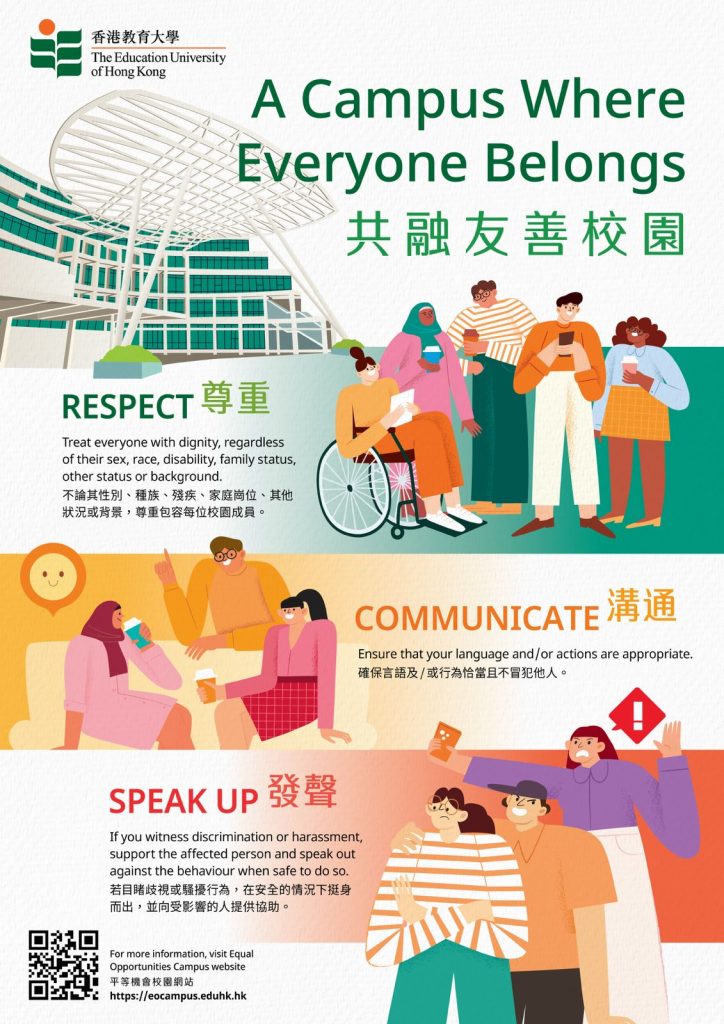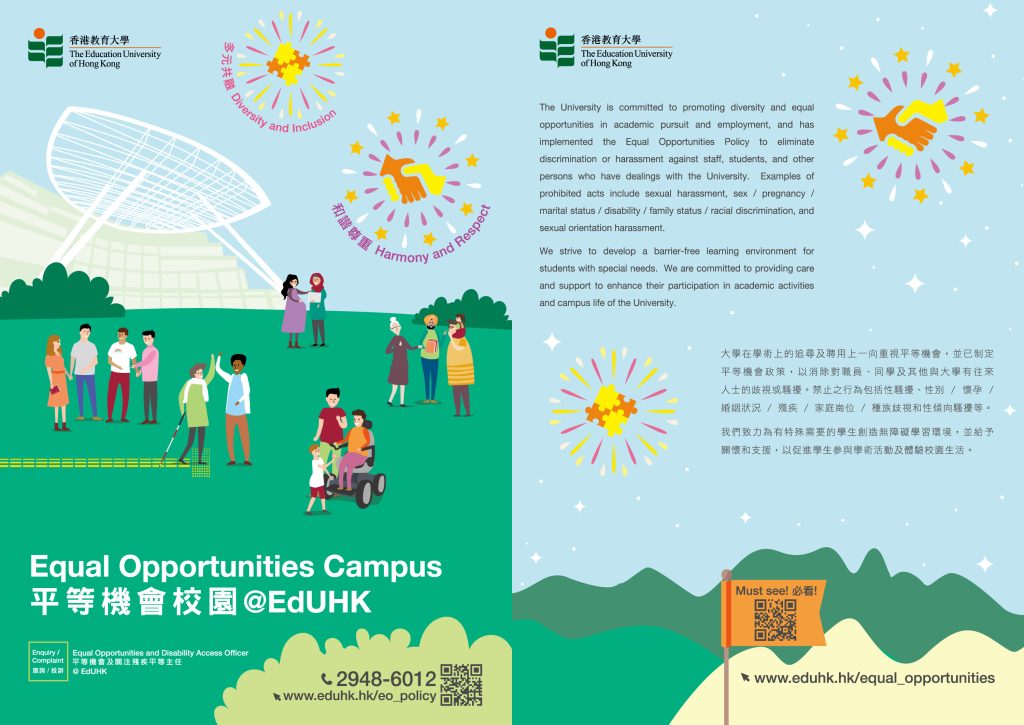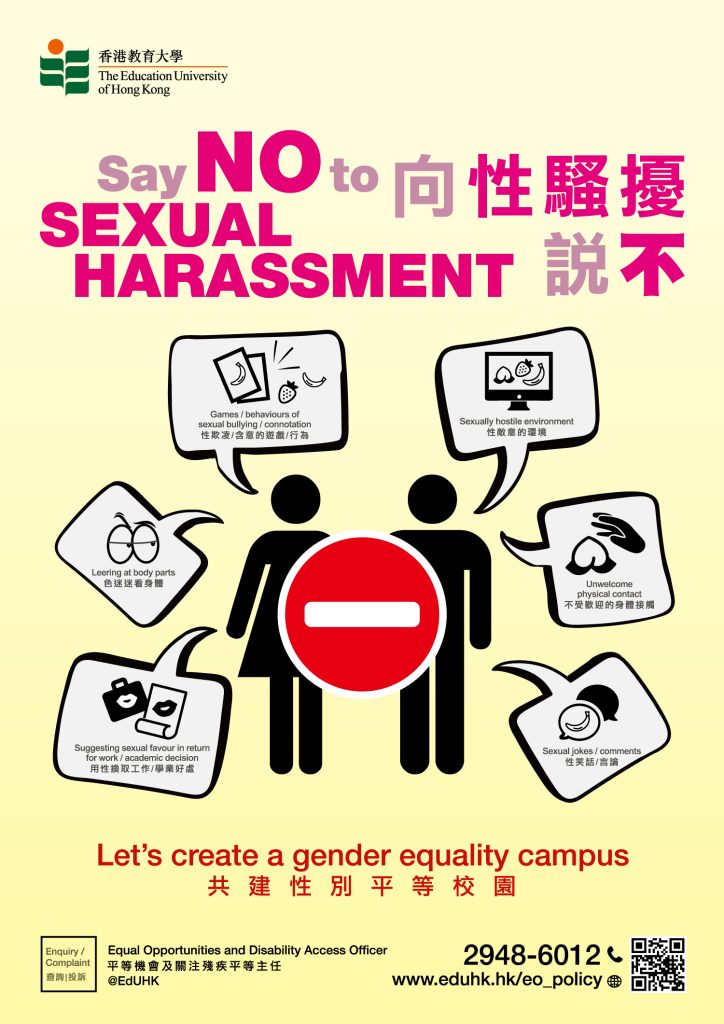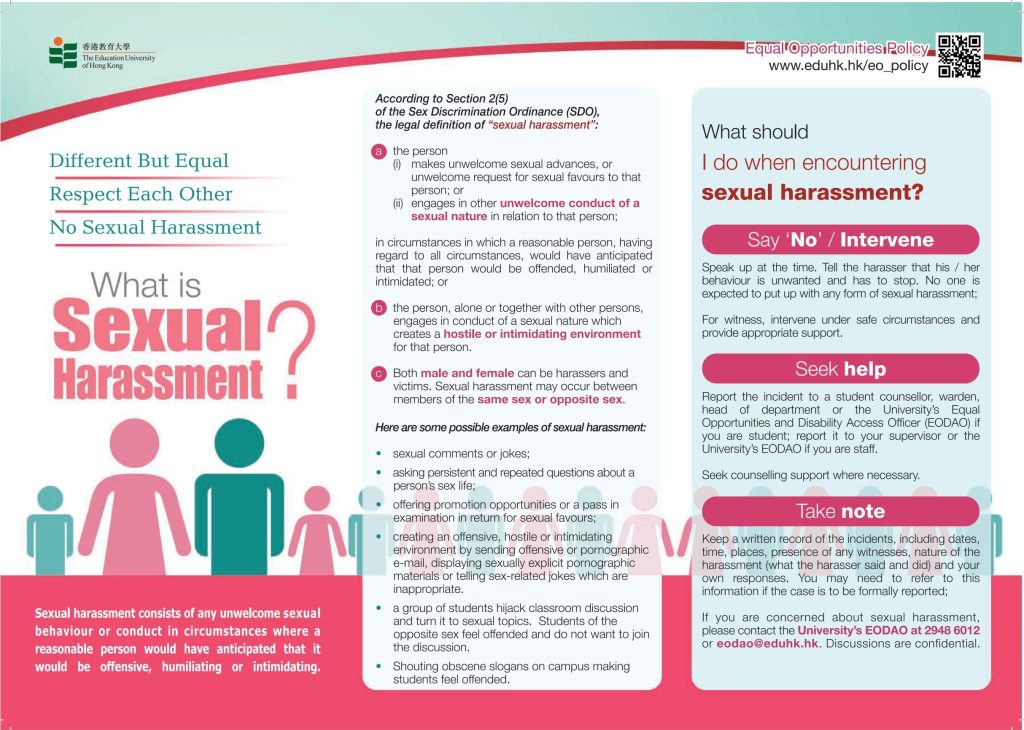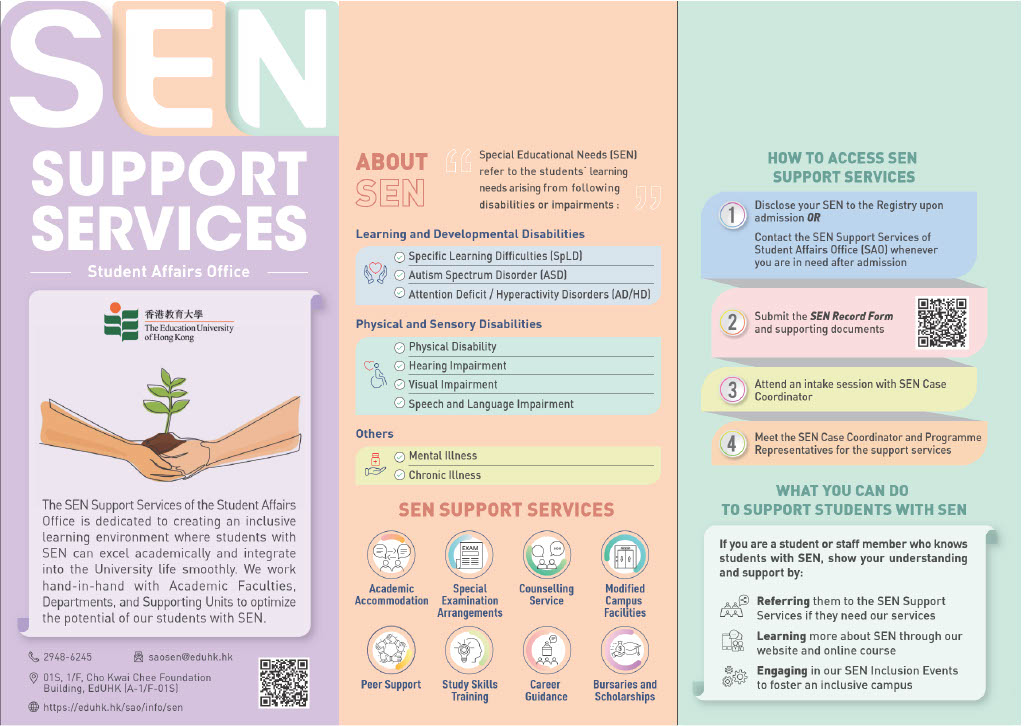
The University has zero tolerance for discrimination and harassment. Everyone, irrespective of their race, colour, sex, sexual orientation, disability, family status, language, religion, political or other opinion, national or social origin, other status, has the right to be respected and be treated fairly. University members should take all necessary steps to ensure that any member, staff or student of the University, or any other person who has dealings with the University is not subject to discrimination or harassment.
There are four anti-discrimination ordinances in Hong Kong:
- Sex Discrimination Ordinance
- Disability Discrimination Ordinance
- Family Status Discrimination Ordinance
- Race Discrimination Ordinance
Under the anti-discrimination ordinances, it is unlawful to discriminate against a person on the grounds of sex, marital status, pregnancy, breastfeeding, disability, family status and race in the prescribed areas of activities, including employment, education, provision of goods, services and/or facilities, disposal and/or management of premises, and participation in clubs.
In addition to the above, the University’s Equal Opportunities Policy also covers complaints concerning sexual orientation harassment in addition to the 4 anti-discrimination ordinances.
For Definitions and Examples of Discriminatory Acts covered under the University’s Equal Opportunities Policy, please refer to Appendix I of the University’s Equal Opportunities Policy.
What is Sex Discrimination Ordinance (SDO)?
Discrimination on the basis of sex, marital status, pregnancy and breastfeeding. Under this ordinance, it is also unlawful to sexually harass another person.
Example 1: Denying admission to a student because she is pregnant.
Example 2: Refusing to hire a married woman even though she is the most suitable person.
What is Disability Discrimination Ordinance (DDO)?
It is a law that has been enacted to protect people with a disability against discrimination, harassment and vilification on the ground of their or their associates’ disabilities.
Disabilities refer to a wide range of physical and mental illnesses or conditions. Examples include autism, attention-deficit and hyperactivity disorder, hearing impairment, mental illness, physical handicap, specific learning difficulties, speech and visual impairment.
Example 1: An employee who has recovered from psychiatric disorder is dismissed because the employer thinks that his/her disability will relapse in the future.
Example 2: An educational establishment denies admission to or expel a student on the ground of disability.
What is Family Status Discrimination Ordinance (FSDO)?
FSDO makes unlawful for anyone or any organization to discriminate against a person, male or female, on the basis of family status. Family status means that a person has the responsibility for the care of an immediate family member. An immediate family member is a person who is related by blood, marriage, adoption or affinity.
Example 1: An employer transfers an employee with a newborn child to another position despite the employee’s refusal because the employer thinks that a woman with an infant will not be able to travel.
Example 2: An educational establishment denies admission to, or expels a student, because he/she has a newborn child.
What is Racial Discrimination Ordinance (RDO)?
RDO protects people against discrimination, harassment and vilification on the ground of their race. According to the RDO, race in relation to a person means the race, colour, descent, national or ethnic origin of the person.
Example 1: A blanket ban on beards for all staff and students may indirectly discriminate against some ethnic groups (who by their custom have to keep a beard), when compared to other racial groups, if information shows that the blanket ban is not justifiable.
Example 2: An ethnic minority is not being selected for interview of a position which requires Chinese capability because the employer assumes that he/she cannot speak fluent Cantonese based on his/her appearance in the photo on the application form.
What is Sexual Orientation Harassment?
“Sexual orientation” means heterosexuality (sexual inclination towards persons of the opposite sex), homosexuality (sexual inclination towards persons of the same sex), and bisexuality (sexual inclination towards persons of both sexes). Sexual orientation harassment is an unwelcome verbal or physical conduct on grounds of a person’ sexual orientation. It can go beyond the treatment of persons of different sexual orientation themselves: harassment can affect people who are in some way associated with those persons. In determining whether certain conduct constitutes sexual orientation harassment, the entire record and the totality of circumstances will be considered.
1. Act early and say ‘No’
Speak up at the time and tell the harasser that his/her behaviour is inappropriate and has to stop. No one should tolerate any form of harassment and discrimination. If you wish to stop the behaviour in a more indirect way, starting a new topic or expressing yourself with body language (e.g. not responding or avoiding physical contact) would be useful. Similarly, if you encounter the above circumstances, you must stop the inappropriate behaviour to maintain the relationship of mutual respect.
2. Seek Help
If you would like to seek immediate assistance from university security, please call the 24-hour emergency number 2948 8002 or visit the Security Control Center (A-G/F-03). You may also report the case to the police where necessary.
In general, you may seek assistance from Counsellor, Warden, Head of Department, supervisor, Equal Opportunities Coordinators or EdUHK’s Equal Opportunities and Disability Access Officer (Click HERE for contact details of relevant support and counselling services).
If you wish to seek support outside campus, you may contact Equal Opportunities Commission.
3. Record the Incident
Keep a written record of the harassment or discrimination incidents, including dates, time, places, people involved, sequence of the event and actions taken by yourself. You may need to refer to this information if the case is formally reported.
1. Being a Supportive Bystander
If it is safe, support the affected individual by checking in on them and offering assistance.
2. Intervene
If appropriate and safe, speak up against inappropriate behaviour. A simple statement like, “That’s not okay” can make a difference. At the same time, remove the victim from the scene.
3. Assist the Victim to Report
If the affected individual is hesitant to report, offer to help him/her navigate the reporting process or accompany them for support.
4. Testify as a Witness for the Victim
If necessary, provide an honest and accurate account of what you witnessed to ensure proper action can be taken.
Creating a safe, respectful, and inclusive environment requires the collective effort of everyone in the community. Here are some practical steps to help prevent discrimination and harassment in daily interactions:
1. Foster Respect and Inclusivity
- Treat everyone with dignity, regardless of their sex, gender, race, disability, family status, beliefs and background etc.
- Be mindful of language and behavior to ensure they do not cause discomfort or offense.
- Celebrate diversity and promote a culture of inclusion in your workplace, classroom, and/or community.
2. Be Aware of Unconscious Bias
- Recognize that biases exist and can influence behavior, decisions, and interactions.
- Challenge stereotypes and avoid making assumptions about others based on identity or appearance.
3. Communicate Clearly and Respect Boundaries
- Ensure that jokes, comments, or actions are appropriate.
- Always seek clear and enthusiastic consent for physical contact or personal interactions.
- If someone expresses discomfort, respect their feelings and adjust your behavior accordingly.
4. Practice Safe Drinking* and Responsible Social Behavior
- Be mindful of alcohol consumption in social settings to maintain awareness and control.
- Never pressure others into drinking or engaging in behavior they are uncomfortable with.
- Look out for peers—help ensure that everyone gets home safely and intervene if someone is in a vulnerable situation.
*Note: NO alcohol drinking is allowed in university activities and/or on campus.
For students: If you are 18 years old or above and drink alcohol:
- Be aware of your alcohol
- Know your limit. Keep track of how many drinks you have consumed and don’t go beyond the limit.
- Know what is in your cup. Do not leave your drink unattended and do not accept drinks from a stranger.
- Get help right away
- If you feel drunk or if the effect of alcohol is stronger than usual, find someone reliable to help you.
5. Speak Up Against Inappropriate Behavior
- If you witness discrimination or harassment, support the affected person and speak out against the behavior when safe to do so.
- Report incidents through appropriate channels to ensure accountability and action.
- Encourage open discussions on respectful conduct and inclusivity within your community.
6. Educate Yourself and Stay Informed
- Participate in training workshops/online training modules on equal opportunities and harassment prevention.
- Stay updated on policies and legal protections related to discrimination and harassment.
- Be proactive in learning about different cultures, identities, and perspectives to foster understanding and empathy.

